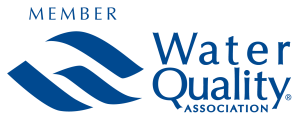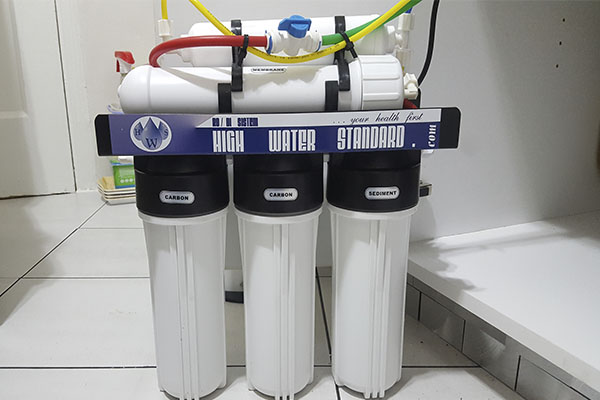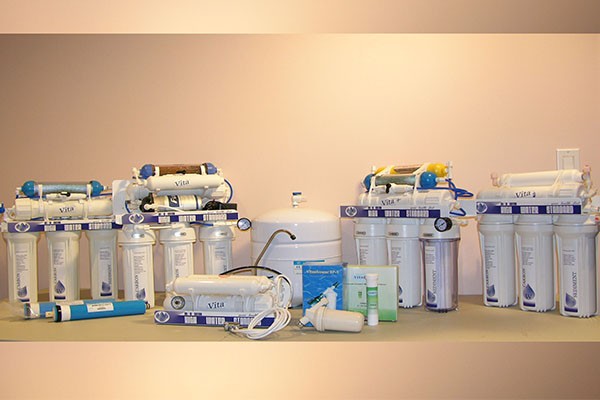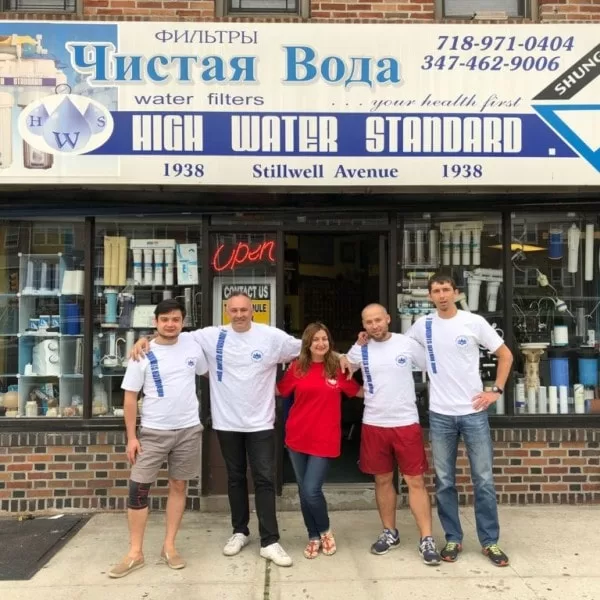A reverse osmosis water system delivers great-tasting water to your home or business without breaking your budget. But do you know exactly how it works, that it can be used under sinks, attach to an ice-maker, or that you can purchase a whole house or commercial RO water system, and it can improve your quality of life?
They are also commonly used by homebrewers and by those who have aquariums as well as a host of industries such as pharmaceutical, laboratories, food and beverage and mining to remove a variety of impurities, salts, bacteria, dyes, proteins and other contaminants from their water supply.
To help answer your questions about a reverse osmosis water system we will discuss:
- The definition of a reverse osmosis water filtration system
- How reverse osmosis works
- The benefits of reverse osmosis drinking water
- The function of a reverse osmosis filter
- The essential components of a whole house reverse osmosis water system
- Stages of the reverse osmosis water filtration process
- Which contaminants a whole house reverse osmosis water system removes
- Differences among reverse osmosis drinking water system and filter types
- How you can get a reverse osmosis water system for home
- Servicing and maintenance of a reverse osmosis system
- The lifespan of a reverse osmosis drinking water system
- What is reverse osmosis drinking water?
Definition of a Reverse Osmosis Water System
What does reverse osmosis mean? Reverse osmosis is technology that removes most of the contaminants found in regular drinking water, such as dissolved salts, bacteria, colloids and pyrogens. It works by creating pressure, forcing water through a reverse osmosis membrane, which filters out large particles. After the process is complete, waste products and contaminants on the “concentrate” side go directly down the drain, leaving clean water for drinking on the “permeate” side.
How Reverse Osmosis Works in More Detail
A high-pressure pump forces tap water through the reverse osmosis membrane. Unfiltered water contains concentrated contaminants and is known as the reject or “concentrate” stream.
The water penetrates the reverse osmosis membrane under pressure, allowing water molecules to pass through but preventing contaminants from doing the same. The concentrate stream then exits the system via normal sewage or waste disposal pipes.
What Does a Reverse Osmosis Filter Do?
Many contaminants, particularly those which negatively affect the taste and odor of water, do not fall under EPA regulations and, therefore, may be present in tap water. It is common to find tap water with a bad smell or taste, even though it usually is safe to drink. Reverse osmosis improves it by filtering out impurities, leaving you with excellent-tasting, refreshing drinking water.
A reverse osmosis water filtration system:
- Provides great-tasting water
- Is safe and effective
- Works automatically
- Is affordable
Basic Components of a Reverse Osmosis System
Aside from the reverse osmosis membrane, other components of a reverse osmosis system include pre- and post-filters, which help to protect the system from sediment in tap water and further enhance the taste of your drinking water.
A storage tank typically holds two to four gallons of water, and your system will automatically refill the supply, ensuring you have a constant flow of safe, tasty drinking water. Your system will come with a special faucet to fit on your sink, providing you with reverse osmosis drinking water.
Other components include the cold water line valve that feeds water into the system and an automatic shut-off valve to prevent your storage tank from overfilling.
Stages of Reverse Osmosis Water Filtration
Many systems have multiple stages to ensure the long life of the system and effective removal of a variety of contaminants. Here are some standard functions of reverse osmosis filtration systems:
- Sediment removal — The pre-filter removes large, rough particles such as sand and rust, which can damage the system.
- Carbon removal — A carbon filter works to remove chlorine and other chemicals that pose a risk to the reverse osmosis membrane.
- Reverse osmosis — This purifies water and removes dissolved solids, including anything larger than the water molecules.
- Storage tank — The water is then transferred to the storage tank, ready to be dispensed via your special faucet.
- Final carbon filter — Another carbon filter removes any unusual tastes or odors that the water may have picked up from the tank.
What Contaminants Does Reverse Osmosis Remove from Water?
Reverse osmosis is effective in removing up to 99%+ of dissolved salts, or “ions,” organics, bacteria, pyrogens colloids, and particles from water. Note that it does not guarantee complete removal of bacteria and viruses from the water supply. Any contaminant with a molecular weight of over 200 is likely to exit water during reverse osmosis filtration.
Ionic charge is also significant. The greater the ionic charge of a contaminant, the higher the likelihood of reverse osmosis successfully filtering it out. It is more effective at filtering calcium, which has two charges, compared to sodium, a monovalent particle with one charge.
Differences Among Reverse Osmosis Drinking Water Systems and Filters
There are many different reverse osmosis water filtration systems on the market. While one reverse osmosis water system may look like the next regarding design and components, there can be substantial differences between systems. The key ways in which reverse osmosis systems differ are:
- The number of stages
- How many gallons of water they can filter per day
- Component quality
Component quality may be the most significant difference. In our experience, spanning over 15 years in the industry, we’ve found the quality of components can vary considerably. Superior craftsmanship results in better-quality water.
When purchasing a reverse osmosis water system, always look for trusted manufacturers, with FDA- and NSF-approved materials and good reviews.
However, it’s also essential to conduct research and find out if the filter you’re buying filters the right contaminants for your area’s water supply. At High Water Standard, we can help you to make a smart choice when purchasing your reverse osmosis water filter.
Different systems also perform various functions.
- Point-of-use (POU) systems filter water at a specific faucet you use for drinking water. You can also connect reverse osmosis filtration systems to supply your refrigerator and ice maker so you can enjoy pure and refreshing drinking water on demand.
- Point-of-entry (POE) systems filter the entire water supply within your home. This means you’ll have the benefits of purified water for all your appliances and faucets in the house. Reduced calcium content in your water supply can extend the life of your appliances by preventing limescale.
- Commercial systems may vary considerably. In some cases, large commercial reverse osmosis filtration systems use electric pumps to generate water pressure. Even in these cases, power consumption is typically lower than alternative filtration methods.
At High Water Standard, we provide a variety of large reverse osmosis systems to meet the requirements of your business or home.
What Are the Benefits of a Reverse Osmosis Drinking Water System?
- It eliminates sodium
A key advantage of using a reverse osmosis water filtration system is the removal of sodium from your water supply. Water softeners only remove hard water minerals like iron, leaving sodium behind, which can contribute to high blood pressure, liver problems, and kidney disease. - It eliminates lead
Reverse osmosis effectively eliminates lead, which may cause an array of health issues. Scientists have linked lead to fertility problems, nerve and brain damage, and more. - It lowers energy costs
Generally, reverse osmosis systems consume less energy. High efficiency allows for savings on your electricity bills while providing you with some of the purest water possible. - It takes up little space
A reverse osmosis water system can either fit under the kitchen sink or in a corner, ideal for a home with limited space. If you require a more constant supply of purified water, larger systems with greater capacity are available as well. You can find the right system for your home or business, regardless of size. - It’s easy to maintain
Routine maintenance only includes replacing filters every six months or so. You can replace the filters yourself or call a professional company like High Water Standard to do it for you. - It produces better-tasting water
Taste is personal to everyone. However, reverse osmosis systems remove minerals such as chlorine and iron which commonly affect the odor and taste of water. If you dislike the smell of chlorine or the subtle taste of iron in your drinking water, reverse osmosis could provide you with a solution. - It replaces bottled water
Many bottled water companies use reverse osmosis to purify their water, which means you can save money by simply bottling water from the tap. It will always be right there whenever you’re thirsty, heading out for a run, or going to work.
How Much Service and Maintenance Does a Reverse Osmosis System Require?
One benefit of a reverse osmosis drinking water system is its ease of maintenance. You normally won’t have to even look at the filters for six months or perhaps even longer. Here are the most common schedules for changing filters:
- Sediment and carbon pre-filters — once every 6 to 12 months
- Reverse osmosis membrane — every 2 to 3 years
- Carbon post-filter — once a year
This is just a general guideline. Check with your manufacturer regarding the specifics of your filters. If you aren’t sure, give us a call, and we’ll provide you with a system evaluation.
Our reverse osmosis systems work without electricity, instead relying on water pressure. Some commercial systems require electrically powered pumps, but energy consumption is relatively low.
We also recommend you conduct annual maintenance to sanitize your filter systems and change any filters as necessary. Our water treatment professionals can handle this for you. If you’re a do-it-yourself type, we also carry kits and filters required to perform maintenance independently.
How Long Does a Reverse Osmosis Drinking Water System Last?
Properly maintained systems that receive regular cleanings and filter changes at recommended intervals can last for as long as 10 to 15 years. We recommend you acquire replacement filters directly from us. Our filters provide the highest quality and optimal performance to help keep your system running longer.
Q: Is it safe to drink reverse osmosis water?
A: Distilled and reverse osmosis water both lack minerals. However, ingesting purified water doesn’t harm your body in any way.
Q: Is reverse osmosis water acidic or alkaline?
A: Reverse osmosis can reduce ordinary water’s pH of 7 down to around 5.5 or lower, becoming acidic. If you wish to alkalize the water, you must add minerals such as calcium to raise its pH.
Q: Is bottled water reverse osmosis?
A: Yes. Bottle water companies often use reverse osmosis to purify their water. A reverse osmosis system at home or work provides the same purity of water directly from the tap.
Q: Does reverse osmosis remove bacteria?
A: It removes bacteria and viruses from water, as they cannot pass through the reverse osmosis membrane. Also, it also blocks out smaller molecules such as salt.
Q: Is drinking reverse osmosis water bad for you?
A: A reverse osmosis water system minimizes the concentrations of contaminants in ordinary water, which reduces allergic reactions to the chemicals or minerals found in it. Reverse osmosis water lacks minerals, but that doesn’t mean ingesting purified water is bad for you.
Q: Does reverse osmosis remove fluoride?
A: A 2008 University of Nebraska guide indicates that reverse osmosis removes many dissolved minerals from water, including calcium and magnesium, plus pesticide contaminants and solid particles. The guide further suggests that reverse osmosis systems filter out fluoride from water.
Q: Does reverse osmosis remove chlorine?
A: Reverse osmosis systems include both a reverse osmosis membrane and a carbon filter system. Together, these filters are highly effective at filtering out chloramines.
Q: Does reverse osmosis remove lead?
A: Properly functioning reverse osmosis systems are effective at removing many common chemical contaminants. These include chloride, copper, chromium, sodium, and lead.
Get Yourself a Reverse Osmosis Water System for Home
At High Water Standard, we aim to educate by explaining what a reverse osmosis water system is and how the process works. You might still have some questions or be considering RO water filter installation in your home or business premises.
Let us offer you some advice on the reverse osmosis systems which are right for you and explain why. It’s up to you if you decide to make a purchase.
Our goal is to provide homes and businesses with the best water treatment solution. During our 15 years in the industry, we’ve had the opportunity to serve New Yorkers with water treatment systems, spanning all five New York City boroughs, North New Jersey, Upstate, and Long Island.
By improving water, we improve lives. Our custom water treatment services can help you save on important things like time, and money, improve your health and quality of life. The right reverse osmosis water filtration system can provide you with a constant supply of pure water.
Contact High Water Standard today. Our team of experts is happy to answer your questions and help you make an informed choice on which water filtration system is most suitable for your home or business.










